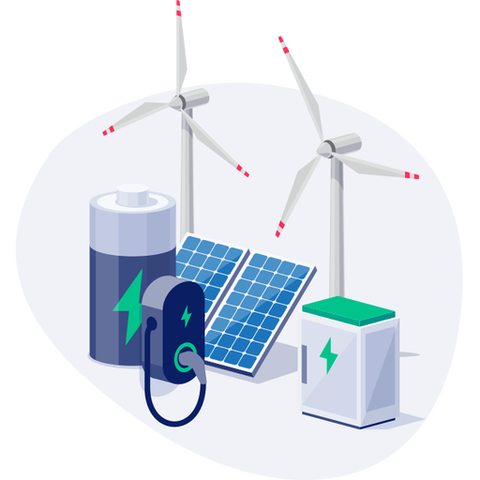Public discourse is chockful of discussions about renewable energy sources. After all, we’re amid a worldwide crisis exacerbated by factors like the war between Ukraine and Russia, with results like sky-high inflation, widespread poverty, and rampant recessions.
Renewable energy is an even more relevant talking point when compounding the energy crisis with a festering climate crisis. Communities call for resiliency against the pitfalls of inclement weather like hurricanes and tornadoes.
Modular microgrids are steadily gaining prominence as potential solutions to the above issues. These autonomous renewable energy sources operate outside the public grid, offering end-users a potentially failsafe alternative.
Below, we’ll explore the finer points of modular microgrids and their significant role in the oncoming autonomous power generation.
What Is Autonomous Power?
Autonomous power systems streamline distributed renewable energy integration. They can combine cooling, heat, and power and decrease transmission losses. Also, they aid in local power regulation, providing enhanced abilities in shaping the net load.
Advantages of autonomous power include:
- They’re independent of the main power grid, offering power during grid disruptions due to outages caused by severe weather or cyberattacks.
- Offer consistent, reliable power. This is crucial for data centres and hospitals where even momentarily outages can have dire results.
- Cost efficiency is a big-picture benefit of autonomous power systems since they eliminate costly maintenance and infrastructural needs. They also decrease homes and businesses’ reliance on skyrocketing grid-power prices while offering extra power to be sold back to the grid.
- Environmental sustainability and flexibility are valuable traits of many autonomous sources. Many can cut down carbon emissions, for instance.
Autonomous power systems streamline distributed renewable energy integration. They can combine cooling, heat, and power and decrease transmission losses.
What are Microgrids?
First and foremost, microgrids are an autonomous power source. They are self-sufficient systems supplying energy to specific areas (e.g., neighbourhoods, schools, or hospital groupings).
Proximity is the name of the game for microgrids. Namely, close proximity is where these grids shine.
Grids on a more macro level (e.g., those generating from a powerplant) are far from their customers. Thus, customers are stuck with substations, long transmission lines, and distribution lines that often cause further inefficiencies in the primary grid system. Estimates show that 15% of power is lost under these circumstances.
Microgrids cut into this distance and inefficiency since they’re installed close to their end users.
They typically include generators, loads, batteries, and smart controllers. They also maintain central grid connections to use that power when it makes more sense and to increase reliability.

Today’s microgrids are powered by photovoltaics, hydropower, wind, biogas plants, and other such renewable energy sources.
The smart-controlled nature of microgrids enables it to achieve various environmentally-dependent objectives. Examples include supplying the cheapest possible energy sources or using the most possible clean energy while maintaining peak functionality.
Today’s microgrids are powered by photovoltaics, hydropower, wind, biogas plants, and other such renewable energy sources.
Storage systems or combined heat/power generation can help balance energy generation fluctuations, further promoting reliability.
Upfront pricing impeding widespread adoption of Microgrids
Theoretically, microgrids provide cost savings in the long term. However, getting from that a-to-b in the big picture can be an arduous, seemingly never-ending journey.
Even the most frugal, cost-efficient microgrid comes with upfront costs that customers can have difficulty justifying. Yes, there will be a return on investment…eventually–but we live in a society that demands more immediate results. These are challenging financial times, and long-term investments with exorbitant upfront costs can be far too risky in this precarious landscape.
Case in point, some reports show the lowest microgrid cost per milliwatt is around $2 million.

Modular (and scalable) battery-based microgrid systems solve the issue of high upfront investment costs.
According to Go Electric's Gordon Campbell, battery-enabled microgrid systems are a continued source of strife for many current and potential end-users. However, this is only one part of the conversation, limited by existing processes and chemistry.
Change can be more seamlessly implemented by offsetting microgrid system soft costs from custom installation and engineering.
One historical comparison that can shed light on this matter is the standardised reactor specifications used in European nuclear energy generation. Conversely, the US allowed for more variations and customisations.
The result? Costs to build nuclear plants in the EU were stable, and prices in the US were more volatile.
Making things modular
A lack of standardised designs for microgrids will all but ensure installation costs remain too high for more widespread usage. Engineering complexity will be too vast to keep prices under control.
Modular (and scalable) battery-based microgrid systems solve the issue of high upfront investment costs.
A standardised unit enables one microgrid to be built, experimented with, and deployed. No customised installation and engineering are required.
An example discussed by Campbell incorporates a microgrid battery energy storage system, controls, and switchgear in a standard arrangement. Tweaks can be made to increase resilience as customer needs evolve. Engineering will occur at the manufacturing facility, while integration engineering will be catered to the site. Installation will merely necessitate the following tasks:
- Pouring a concrete pad.
- Connecting to the load centre.
- Connecting distributed energy resources.
- System levelling.
- Field commissioning the controls.
The above steps are much less intensive than the engineering and installation activity required for traditional microgrid installations. Thus, installation costs will be vastly reduced.
When processes are repeatable and more easily replicated, the associated labour costs tend to plummet.

The magic behind modular
The concept behind modularity is at the crux of making microgrids widespread. Specifically, we’ll look at one definition of “modular:” Something built with standardised dimensions or units for flexible usage.
Making a standardised version of something turns it into (in lay terms) a templated model. Modular microgrids mean customers and installers can essentially drag and drop a blueprint.
When processes are repeatable and more easily replicated, the associated labour costs tend to plummet.
Let’s use McDonald’s as an example.
One of the primary reasons the fast-food conglomerate can serve a broader customer base is it makes more for less throughout countless locations. Thus, those products can be sold for less than the food at a Michelin-star restaurant, which makes bespoke dishes. There’s a reason McDonald’s is worth billions of dollars, and a gourmet restaurant isn’t.
However, modularised microgrids stand to offer the world far more benefits than any fast-food chain.
They can provide infrastructural reliability and energy-based autonomy beyond central power grids with sustainable energy, much to the benefit of our struggling environment.